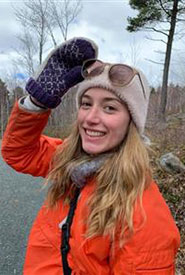A week away: Cape Breton Island
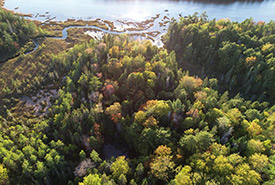
Cain's Mountain (Photo by Mike Dembeck)
Being able to work directly in nature is one of the reasons I love working as a conservation intern for the Nature Conservancy of Canada (NCC).
Gaining more field work experience at NCC as the summer weeks progressed made for an epic, four-night expedition to dreamy Cape Breton Island, Nova Scotia. NCC protects nature by securing properties for conservation. And in 2017, NCC secured approximately 274 hectares (677 acres) in Nova Scotia, including land west of Lake Ainslie in central Cape Breton, which I had the pleasure of visiting in the fourth week of June. (PS: It’s NCC’s 50th anniversary in Atlantic Region. The first project was actually in Sight Point, Cape Breton in 1971!)
My supervisors, Doug van Hemessen and Haley Macdonald, as well as fellow intern Ben Gormley and I travelled nearly 350 kilometres from Halifax to our beautiful cabin, right on Lake Ainslie. We went to five properties altogether, including Cains Mountain Wilderness Area and the Black River Bog Nature Reserve. My supervisor was impressed with the amount of work we got done. We also managed to squeeze in a lot of fun between working. Swimming, board games and sunset yoga became a nightly ritual. Home-cooked meals from the Farmer’s Daughter (a local farmer’s market and diner) and Charlene’s (a family-owned restaurant) were enjoyed every day, before and after a hard day’s work classifying forest types. This meant bushwacking through thick forests and climbing over gypsum boulders. On our final night, the team decided to relish a meal from the Glenora Distillery as we celebrated a successful work week.
Here are a few highlights to summarize my wonderful week away:
You learn to work whether rain or shine
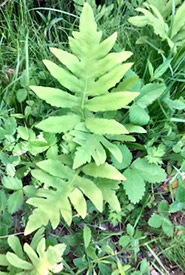
Sensitive fern (Photo by NCC)
Being outside boosted my energy and filled my spirits, despite bleak weather. It rained two out of the four days that our conservation team hiked the properties. But didn't let the rain take away our fun; as field biologists, we must be ready for all kinds of weather. The plants were wet, which made it inevitable that we got wet while bushwhacking. We were mostly doing baseline inventory work, which means investigating an entire property and classifying different ecosystem types. Forests are made up of a mosaic of ecoregions, all interrelated and overlapping. It is our job to walk the whole property and try our best to differentiate the ecoregions.
The diversity of ecoregions within a single ecosystem is outstanding. There are plants that indicate different ecosystem types. For example, black spruce, Labrador tea, and sphagnum moss are indicative of a wet coniferous forest.
You get to see incredible geography
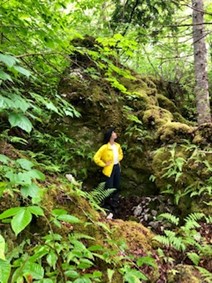
Me standing on karst topography at Cains Mountain, NS (Photo by NCC)
One of the most interesting features that we ran into was karst. Karst is a dramatic, gypsum-based geological formation, made up of white cliffs, sinkholes and caves. Cape Breton contains some of North America’s finest and longest-standing karst outcrops (boulders visible on the earth). Easily broken down, karst leaches calcium and nutrients into the ground, enriching the composition of the soil, ultimately supporting sensitive old Acadian forests and freshwater wetlands.
You encounter new-to-you species
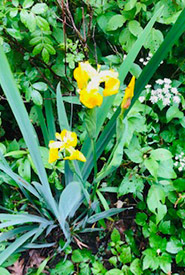
Yellow iris (Photo by NCC)
I love my job as an environmental scientist/conservationist because working in the woods is a hands-on learning experience. I am always surprised by what wildlife is out there watching me. I was lucky enough to witness a barred owl watching me from above as I studied the forest around me. While there was a lot to learn and observe in the field, I was specifically interested in learning more about two new-to-me plant species: sensitive fern and yellow iris. The name sensitive fern refers to the plant’s intolerance to frost. On the other hand, yellow iris is a non-native plant that can prevent the establishment of native wetland species by forming a dense canopy, stopping sunlight from reaching the ground.
You meet great people who care about protecting nature
I also had the good fortune to meet volunteers who help care for the land: Craig, Susan and their trusty husky pal, Gus. They warmly welcomed us in for some tea, showed us their garden and we walked the property and looked for any new disturbances. As true “Capers” would, they even sent us off with some treats from their garden to share with our friends and family!
A key take-away from the week was knowing that we were on the unceded territory of the Unama’ki Mi’kmaq and are working to build a relationship with the Unama’ki Institute of Natural Resources (UNIR). While the downpour kept Earth Keepers from the Unama’ki Indigenous community from joining us this trip, we hope to work with UNIR in the future to further care for nature in Cape Breton.
With the properties in Cape Breton being so close to each other, it means that species can more easily migrate between conserved areas. This ultimately increases the likelihood of species survival. The properties serve as very special learning opportunities and I love their idyllic setting. I am grateful for the opportunity to get to know the Acadian old-growth forests more deeply, thanks to my NCC internship.

